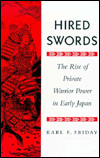Koryu.com Book Reviews
 Hired Swords: The Rise of Private Warrior Power in Japan.
Hired Swords: The Rise of Private Warrior Power in Japan.
By Karl Friday.
Stanford University Press, 1992.
ISBN: 0-8047-1978-0. 266 p. 6" x 9" hardcover.
Purchase from Amazon. (paid link)
Accounts of warriors in Japan almost invariably portray them as sword-wielding ruffians who hacked each other to pieces in a society whose basic institutions had ceased to function. Karl Friday has shown in Hired Swords that the rise to prominence of local elites as warriors stemmed from shrewd court policy. In effect, a large and cumbersome army based upon a continental Chinese model of conscription was abandoned in favor of small, effective units of mounted warriors.
Friday traces the evolution of military institutions of the Japanese state from the seventh through the mid-twelfth century. He explains why a large standing army was not suited to the circumstances of Japan and shows the institutional innovations and transformations which led to the formation of private bands of warriors.
Illustrations of the armor, weapons and other military accouterments (including a gigantic crossbow) pro, vide insight into the life of a warrior. Many readers will undoubtedly find Friday's summary of cavalry and military technology on pp. 35-43 interesting. The effectiveness of cavalry and the time required in training makes the state's "increasing reliance on the martial skills of the provincial elite... and the diminishing use of troops conscripted from the ordinary peasantry" (p. 69) seem like an eminently rational policy.
For readers who are interested in learning about the intricacies of the institutional framework within which warriors operated, Friday's chapter on "The Contract Constabulary" should leave them well satisfied.
Friday shows, too, that most warriors belonged to factions composed of men with shared interests. Land commendation bound men into "vertical groups" which transcended class. Three case studies of local warrior notables show that strife primarily erupted among men of similar status. Additionally, in contrast to commonly held assumptions, fraternal conflict was quite widespread: large clans, such as the Taira or Minamoto, simply were not cohesive aggregate groupings.
In conclusion, Karl Friday has shown that the court of Heian Japan was not staffed with effete poets but shrewd courtiers whose policies enabled the court to retain a monopoly over force (albeit a privatized one) until the 1180's, when their dominance was finally challenged. Hindsight can cloud one's vision, but as Friday states: "until the very end of the twelfth century... fighting men were the servants, not the adversaries, of the court and state" (p. 174). For those seeking an introduction to the world of early Japanese warriors and their role in Japanese history, Hired Swords is a book I heartily recommend.
Tom Conlan
This review first appeared in Journal of Asian Martial Arts 2:3 1993.
Reproduced with kind permission of the author.

Contact Koryu.com
Last modified on October 23, 2019
URL: https://koryu.com /books/hiredswords.html
Copyright ©2022 Koryu Books. All rights reserved.
